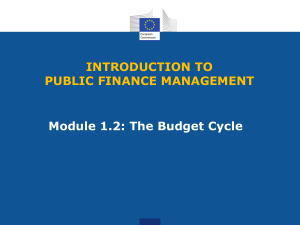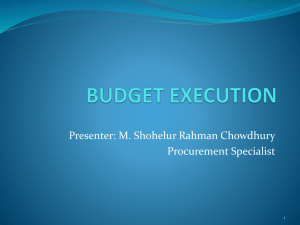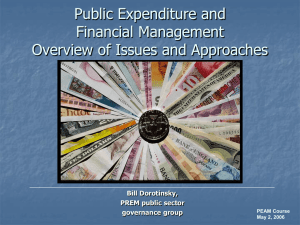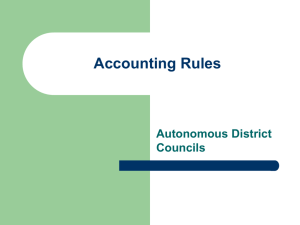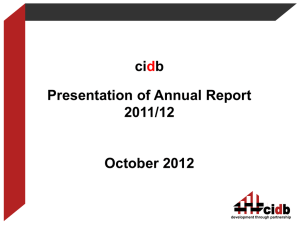International Practice on Budget Execution & Control
advertisement
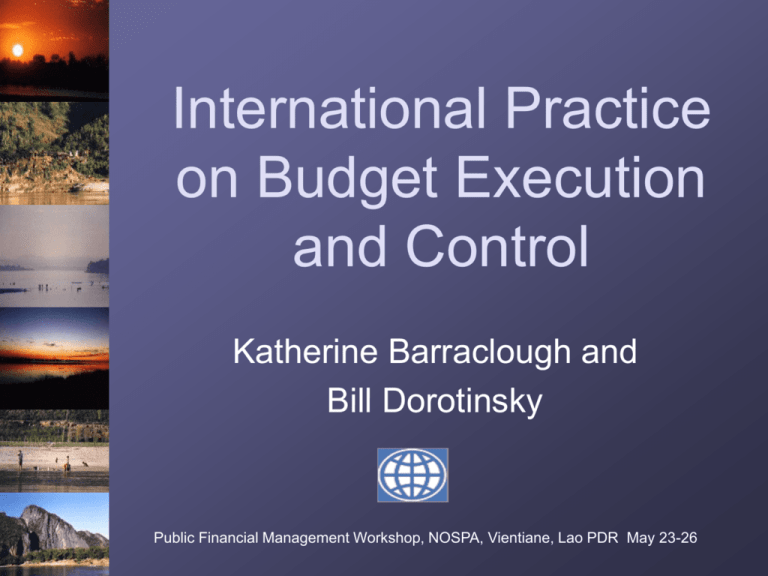
International Practice on Budget Execution and Control Katherine Barraclough and Bill Dorotinsky Public Financial Management Workshop, NOSPA, Vientiane, Lao PDR May 23-26 Budget Execution and Control • Concerned with budget execution, accounting and fiscal reporting Processes and institutions to: • • • • • • Implement the budget Manage resources, assets (and policies) Report on resource use Ex poste audit reports and resource use Key questions: • • • • Are deficit targets going to met? Are budget adjustments that were agreed at the preparation stage being implemented? Will the budget outturn align with the budget plan? Are expenditure priorities being reflected in the budget? Basic Principles for Budgeting • Comprehensiveness • Include all revenue and expenditure, all agencies • Accuracy • Record actual transactions and flows • Annuality • Cover a defined period of time (e.g. one year budget, multi-year forecasts) • Authoritativeness • Ensure implementation is in line with appropriate laws • Transparency • Information on spending is public, timely and understandable • Predictability • Stability in the macro and strategic policy and funding in the short and long term Cash Budget • Advantages: • Appropriations are on a cash basis and define the limits for payment and annual commitment • Fits well with the need for compliance and expenditure control • Expenditures are classified by organisation and object of expenditure (line item) • Disadvantage: • Tendency to overlook issues of government objectives, their links to the budget, and the services to be delivered by the government • This can be overcome through an appropriate classification system Budget Classification (1) • Classification is important for: • Policy formulation • Identification of resources allocation among sectors • Identification of activities of government • Level of performance to be assessed • Establishment of accountability for compliance of authorizations, policies and analysis • Everyday budget administration Budget Classification (2) • Budget can be classified according to: • Function: for historical and high level analysis and policy formulation • Organisation: for accountability and budget ration • Fund: source of financing • Economic: for statistical purposes, compliance, control, and economic analysis • Program: for allocating resources based on government objectives and cost-benefit analysis • Other: as needed based on country circumstances • COFOG and GFS • COFOG: http://unstats.un.org/unsd/cr/registry/regcst.asp?Cl=4 • GFS: http://www.imf.org/external/pubs/ft/gfs/manual/ The Budget Execution Process 1. Authorization Stage: Allotment process for money to be spent consistent with legal appropriations 6. Accounting Stage: Transaction recorded in the books as complete 2. Commitment Stage: when a purchase order is made or a contract is signed 3. Verification Stage: ensuring that goods have been delivered as per the contract 5. Payment Stage: paying the actual bill 4. Payment Authorization Stage: Ordering person is different from the authorizing person Key Considerations • Ability to revise budget appropriations in-year • Excessive switching may indicate a lack of budgetary discipline and/or poor budget formulation • Quality of information on outturn expenditure • Information needs to be timely, accurate, and reliable • Limits on use of exceptional procedures • Avoid excessive use of procedures that by-pass expenditure controls • Adjusting expenditures in year • Only changes in expenditure policy can deliver sustained changes in expenditure levels • Pursuing good governance • Ensuring the basic principles are followed • Areas of responsibility Responsibilities for the CBO • Budget Administration • Administering the system of release of funds • Monitoring expenditure flow • Preparing in-year budget revisions • Managing central payment system/bank accounts • Administering the central payroll system • Consolidating accounts and preparing progress reports • Policy Implementation • Reviewing progress independently or jointly with spending agencies • Identifying policy revisions where appropriate • Proposing to Cabinet reallocations of appropriations Responsibilities for Spending Agencies • Budget Administration • Allotting funds among subordinate units • Making commitments, purchasing and procuring goods and services • Verifying the goods and services acquired • Preparing requests for payment • Preparing progress reports • Monitoring performance indicators • Keeping the books • Policy Implementation • Periodically reviewing the implementation of the program • Identifying problems and implementing adequate solutions • Reallocating resources among sector programs Internal Control (1) • Compliance controls: • • • • Commitment stage: financial control Delivery: verification Before payment: accounting control After final payment: audit Principles of Internal Control Establishment of responsibility Physical, mechanical and electronic controls Segregation of duties Independent internal verifications Documentation procedures Other controls Internal Control (2) Ex Ante (to commitment) Ex Poste External (to spending unit) •Centralized commitment control (transaction approval) •Allocations (commitment limits) •Warrants (cash limits) •Procurement rules •Personnel/pay rules •Central internal audit, external audit •Regular reporting •Quarterly closeouts Internal •Ministry or spending unit transaction approval •Procedures to minimize risk (internal controls) •Ministry internal audit •Performance management • Any system is a mix of approaches • Approaches will vary with fiscal conditions • As with any trend, they can go too far External Control • Independence • • • • Adequate resources, government support and staff Head of Audit Office should be selected on professional merit Independent of the executive Relevant scope of work • Capacity • • • Professional expertise and technical knowledge Access to information Effective working relationship with Ministry of Finance and spending agencies • Impact • • • Available to the public Focus on issues of importance Executive commitment to follow up on findings Issues for Developing Countries Condition Impact on Public Expenditure Poverty Lack of resources to respond to rising demands/expectations for public services. Tendency for budget to be a wish list. Economic Instability Inadequate slack to “ride out” cyclical shocks and other disturbances. Tendency to have a short-term view of budgeting. Low Revenue Base Vulnerability to adverse shifts in commodity prices, terms of trade, and low access to capital markets. Informal Market Sector Much economic activity is extra-legal, in disregard of formal rules and regulations; weak enforcement. Informal Public Sector Formal rules concerning civil service, public expenditure and procurement tend to be ignored or violated. Low Political Mobilization Inadequate development of interest groups to express public opinion and monitor government performance. Schick, A., “A Contemporary Approach to PE,” (World Bank, 1998) 31. Ratings of Public Financial Accountability Elements of a sound public financial system Lao PDR China Vietnam Thailand Korea Cambodia 1 Quality and openness of the budget process 2 Appropriateness of internal financial and performance management systems 3 Quality of public sector accounts and management information 4 Effectiveness of public external audit and evaluation function OVERALL / Ratings: low= medium= high= Source: World Bank, East Asia Update, (2001) Best Practice – budget presentation • Budget information should be presented in a way that facilitates policy analysis and promotes accountability • Budget data should be reported on a gross basis, distinguishing revenue, expenditure, and financing, with expenditure classified by economic, functional, and administrative category. IMF Manual on Fiscal Transparency (2001) Best Practice – budget execution • Procedures for the execution and monitoring of approved expenditure and for collecting revenue should be clearly specified • There should be a comprehensive, integrated system which provides a reliable basis for assessing payment arrears • Budget execution should be internally audited, and audit procedures should be open to review • Frequent reports on budget developments should be presented to the legislature and final accounts should be presented within a year of the end of the fiscal year IMF Manual on Fiscal Transparency (2001)

